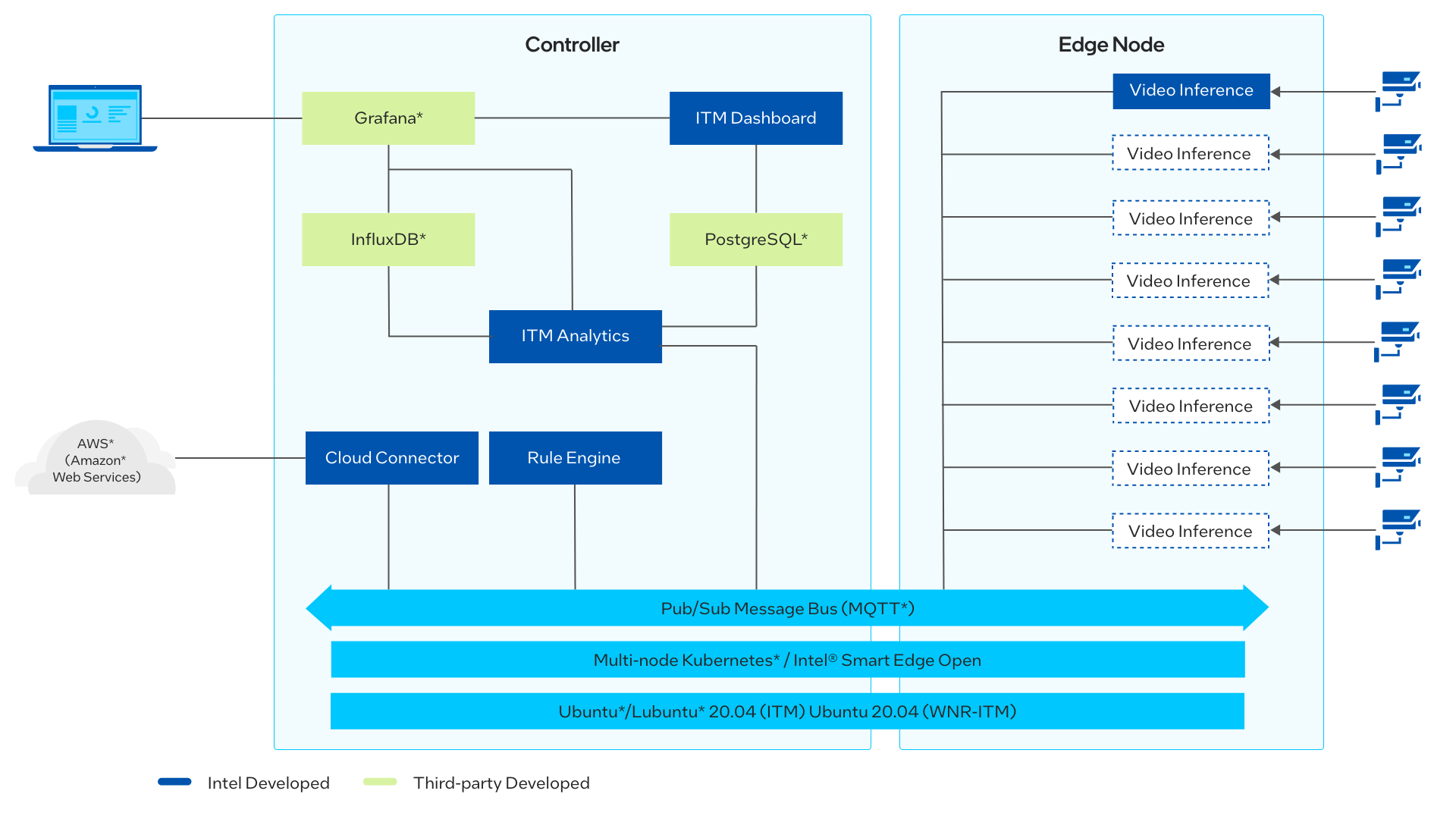Overview
Intelligent Traffic Management is designed to detect and track vehicles as well as pedestrians and to estimate a safety metric for an intersection. Object tracking recognizes the same object across successive frames, giving the ability to estimate trajectories and speeds of the objects. The reference implementation also detects collisions and near misses. A real-time dashboard visualizes the intelligence extracted from the traffic intersection along with annotated video stream(s).
This collected intelligence can be used to adjust traffic lights to optimize the traffic flow of the intersection, or to evaluate and enhance the safety of the intersection by allowing emergency services notifications, such as 911 calls, to be triggered by collision detection, reducing emergency response times.
Try the reference implementation in the Intel® Developer Cloud for the Edge Container Playground powered by Red Hat* OpenShift*, a Kubernetes* environment for testing containers with Intel® hardware.
Launch on Intel® Developer Cloud for the Edge
Select Configure & Download to install and run Intelligent Traffic Management on your device. To get started with installation, view Documentation.
How It Works
The application uses the inference engine and the Intel® Deep Learning Streamer (Intel® DL Streamer) included in the Intel® Distribution of OpenVINO™ toolkit. The solution is designed to detect and track vehicles and pedestrians and upload cloud data to an AWS* S3 storage.
The Intelligent Traffic Management application requires the services pods, database and a visualizer. Once the installation is successful, the application is ready to be deployed using Helm. After the deployment, the application pod takes in the virtual/real RTSP stream addresses and performs inference and sends metadata for each stream to the InfluxDB database. The visualizer in parallel shows the analysis over the metadata like pedestrians detected, observed collisions and processed video feed.
The application has capability to perform inferences over as much as 20 channels. In addition, the visualizer is capable of showing each feed separately as well as all the feeds at the same time using Grafana*. The user can visualize the output remotely over a browser, provided that they are in the same network.

Try It
Launch on Intel® Developer Cloud for the Edge
Try the reference implementation in the Intel® Developer Cloud for the Edge Container Playground powered by Red Hat* OpenShift*, a Kubernetes* environment for testing containers with Intel® hardware.
Launch on Intel® Developer Cloud for the Edge
Features
The following are features are included with Intel® Developer Cloud for the Edge:
- Container Images: grafana:itm, influxdb:1.8, itm:1.5
- Software Stack: Intel® Distribution of OpenVINO™ Toolkit (Intel® Deep Learning Streamer [Intel® DL Streamer]), InfluxDB*, Grafana containers in a Helm-chart
- Task: Object Detection, Tracking and Classification with Intel® DL Streamer (gstreamer pipeline)
- Model Info: Person, vehicle, and bike detection pytorch model with MobileNetV2 backbone
- Precisions Supported: NA
- Outputs: Exposes 2 web-services (URLs). One link showing annotated input streams with fps, tracking IDs, bounding boxes for pedestrians and vehicles with collisions, and one for Grafana dashboard.
Download
Select Configure & Download to install and run Intelligent Traffic Management on your device. To get started with installation, view Documentation.
Features
Time to complete: 30 - 45 minutes
Programming Language: Python* 3
Available Software: The following are included in the Intelligent Traffic Management zip file:
- Intel® Distribution of OpenVINO™ toolkit 2021 Release
- Kubernetes*
Recommended Hardware
The hardware below is recommended for use with this reference implementation. For other suggestions, see Recommended Hardware.
Learn More
To continue your learning, see the following guides and software resources:
Support Forum
If you're unable to resolve your issues, contact the Support Forum.
Commonly Used Together
Connect Edge Devices to Azure IoT*
Helps securely connect devices to Azure IoT*. You are responsible for payment of all third-party charges, including payment for use of Microsoft Azure* services.
Deploy Reference Implementations to Azure IoT* EFLOW
Deploy RIs to Azure* IoT Edge for Linux* on Windows* (EFLOW). You are responsible for payment of all third-party charges, including payment for use of Microsoft Azure* services.